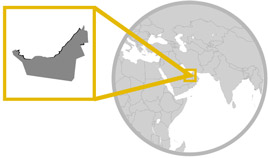Religion
The dominant religion in Bahrain is Islam with around 70% of them being Shia Muslims and the remainder being Sunni Muslims. However, other prominent religions in the country include Hinduism and Catholicism, making up around 10% of the population each.
Additionally, Protestantism makes up 5% of the population, Buddhists make up another 2% and similarly, another 2% are Atheist. Additionally, 1% identify as Orthodox Christians (with about 1000 members) and 1% are said to have other religious beliefs. There is also a very small, close-knit Jewish community of 36-50 people. Believers of non-state religions enjoy religious and social freedoms like any other developed country.
Museums, Galleries & Architecture
Like many other countries in the Gulf region, traditional Bahraini architecture follows an Islamic style with strong use of straight edges with repeated circular symmetry. It’s common to incorporate a wind tower into the design to help ventilate the house or building and typically features a courtyard in the centre of the structure and sometimes a couple of courtyards. The rooftops would be structured to help catch summer breezes and direct them into the house whilst featuring thick walls to keep the house warm during winter months. However, following the economic improvement of the 1970s, western-style buildings became incredibly widespread and today these are more prevalent than their old-world counterparts.
There are only few of museums in Bahrain but these two are incredibly prominent, they include the Bahrain National Museum which was opened in 1988 and serves to document Bahrain’s entire history from contemporary to ancient times as well as the natural and religious histories in the country, and the Beit Al Qaran which is dedicated to the Islamic arts and manuscripts of the Quran.
 Clothing, Dress Style & Etiquette
Clothing, Dress Style & Etiquette
Common rules and social expectations surrounding clothing are more relaxed in Bahrain when compared to its neighbours, but female attire still typically consists of the Hijab (a veil covering the head and chest) and the Abaya (a long robe-like dress covering the whole body).
Male attire typically includes the Thobe (a body-length garment with long sleeves), the Keffiyeh (a type of cloth-like headdress) and the Agal (a thick black cord worn over the keffiyeh to keep it in place).
Literature, Poetry, Music & Dance
Historically, Bahrain is mentioned as the land of Dilmun in the ancient text, the Epic of Gilgamesh, written well over three thousand years ago.
With most authors writing in a classical Arabic style, famous and popular authors include Qassim Haddad, Ahmad Muhammed Al Khalifa, Ali Al-Sharqawi and Ebrahim Al-Arrayedh. However, more recently, poetry has taken on prose and free verse styles centring on both personal and political matters with publications published in Arabic and very rarely in English.
Female writers too are prominent within the region with poetry being a principle skill of Bahraini women starting in the 20
th Century. Notable female writers include Fawziyya Al-Sindi, Fathiya Ajlan, Iman Asiri, Hamda Khamis and Fatima Al-Taytun, it’s said that over one sixth of all poets during the 20
th Century were female.
Calendar & Events
Bahrain’s calendar begins with a holiday on January 1
st for New Years’ day, moves on to the 1
st of May which celebrates another holiday on Labour day, then this is followed with two holidays on National Day and Ascension Day on the 16
th and 17
th of December respectively. Bahrain also celebrates many Islamic holidays like its neighbours, including the Islamic New Year, the Day of Ashura, the Prophet’s birthday, the Little Feast, Arafat Day and the Feast of the Sacrifice.


